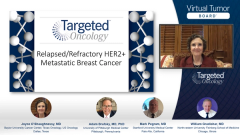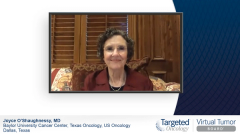
Case 1: 63-Year-Old Woman With Relapsed HER2+ Breast Cancer
The experts discuss a case presentation of a 63-year-old woman with relapsed HER2+ metastatic breast cancer and discuss rate of relapse in this patient population.
Episodes in this series

Joyce O’Shaughnessy, MD: Thank you for joining us for this Targeted Oncology™ Virtual Tumor Board®, which is titled “Relapsed/Refractory HER2+ Metastatic Breast Cancer.” In today’s presentation, my colleagues and I will review 3 clinical cases, discuss an individualized approach to treating each patient, and review the key clinical trial data that impact our decision-making. I am Dr Joyce O’Shaughnessy, from the Baylor University Medical Center, Texas Oncology, and US Oncology in Dallas, Texas. I am joined by Dr Adam Brufsky, from the University of Pittsburgh Medical Center; Dr William Gradishar, from the Northwestern University Feinberg School of Medicine in Chicago; and Dr Mark Pegram from the Stanford University Medical Center in Stanford, California. Thank you so much for joining us. We’re going to have a good time today talking about cases and getting clinically detailed about how we think through the optimal treatment for these patients, particularly in the context of multiple new therapies we have available for HER2 [human epidermal growth factor receptor 2]–positive metastatic breast cancer. With that, I’m going to turn us over to Adam Brufsky, who will talk to us about the first case, a woman with relapsed HER2+ metastatic breast cancer.
Adam Brufsky, MD, PhD: Thank you very much, Joyce. This is a case of relapsed HER2+ metastatic breast cancer, something we do see to some degree, although adjuvant therapy has been successful, especially in the last 5 or 6 years. This is a 63-year-old woman who was diagnosed 4 years ago with a right-sided invasive ductal carcinoma. It was stage IIA that was T1N1M0, grade 3 ER [estrogen receptor] negative and PR [progesterone receptor] negative, and HER2+ by IHC [immunohistochemistry]. She was treated with neoadjuvant TCHP [docetaxel, trastuzumab, pertuzumab, carboplatin]. Most of us would give TCHP, given TRAIN-2, although this was several years ago. Given that TRAIN-2 shows TCHP [docetaxel, trastuzumab, pertuzumab, carboplatin] is equivalent to AC-THP [doxorubicin, cyclophosphamide, paclitaxel, trastuzumab, pertuzumab] with less toxicity, most of us will now use neoadjuvant TCHP [docetaxel, trastuzumab, pertuzumab, carboplatin].
She got neoadjuvant TCHP [docetaxel, trastuzumab, pertuzumab, carboplatin] times 6 and achieved a pathologic complete response [pCR], which is also not uncommon. If you look at some of the current data, both from TRAIN as well as from other trials that have been done in the past, pCRs in the 60% to 80% range are not unexpected with ER-negative HER2+ disease. Despite her pCR—this happens about 10% to 20% of the time—36 months later she had a CT scan that showed disease recurrence in her liver and bone. She had a biopsy of her liver metastasis that showed the same cancer. It was ER-negative/PR-negative, HER2-positive, and it was metastatic breast cancer.
She received the standard regimen that we would give based on CLEOPATRA, THP [docetaxel, trastuzumab, pertuzumab], and achieved a partial response in her liver with some stabilization of bone. Bone disease tends to sclerose and not completely go away most of the time. Twelve months later, she showed disease progression in her liver, and this is on the short end. We expect, from CLEOPATRA, a median progression-free survival of about 18 months, but she progressed early. Still, it was in the range of therapeutic effect, but it was on the low end of the range, and she had a progressive disease in her liver. She was given a standard therapy of T-DM1 [trastuzumab emtansine] and achieved a partial response, which was stable for a few months. Six months after initiating T-DM1 [trastuzumab emtansine], she has several new liver metastases.
Joyce O’Shaughnessy, MD: Thank you. You were pretty clear that you thought that this happens in about 10%, maybe 15% of the time patients with a pCR develop recurrent disease. That’s an interesting point because we think that maybe it was a little lower chance of recurrence. Is that what you think the data show these days?
Adam Brufsky, MD, PhD: If you look at most of the studies, the answer is yes. We expect at least 90%, most of the trials about 90%. If there were data that suggest that the rate is lower, that’s great. A lot of the metastases are CNS [central nervous system]. We’re going to be informed in this setting by KATHERINE, the relapse in KATHERINE, and this is not pCR. These are people who had a response and then went on adjuvant T-DM1 [trastuzumab emtansine] for a year. The distant recurrence rate was 11%, of which 5.6% or roughly half that 11% were CNS disease. This kind of patient is lower, 5% or 6% for systemic progression. But when you include the CNS progression, it going to be higher. I’m curious to see what my colleagues have to say. I always expected there to be about a 10% distant recurrence risk even with pCR.
Joyce O’Shaughnessy, MD: There’s a dataset that is important in this context. It was a meta-analysis from the German Breast Group looking at their relatively recent, over the last 10 years, preoperative therapy study results and looking specifically at their pCR patients. Across every subset, it was about a 15% recurrence. Some of that’s locoregional, as you pointed out; some is distant; some is CNS. Fifteen percent is higher than I expected, so it raises the question about whether we could identify patients with ER-negative/PR-negative disease, stage III disease, who are at greater risk for recurrence in spite of having a pCR. That’s what they showed in the German Breast Group meta-analysis. They showed that node-positive disease and stage III disease were risk factors for having a recurrence in spite of a pCR. Mark, how do you think through this when somebody has a pCR? What do you think in your mind what her risk is of having a recurrence?
Mark Pegram, MD: I look to the data that have been published by [Luca] Gianni on the NeoSphere trial. The experimental arm of THP [docetaxel, trastuzumab, pertuzumab] does have a 15% projected relapse risk by year 5, and the TRYPHAENA study, which was a 3-arm cardiac safety study, a small study with only about 75 patients per arm. They all got HP [trastuzumab, pertuzumab] with various chemotherapy backbones. If you look at the HP [trastuzumab, pertuzumab] arms in composite and look at the pCR subset, the 3-year DFS [disease-free survival] in the pCR group was 88.3%. By 5 years, that’s also going to be north of the 15% relapse risk.
Joyce O’Shaughnessy, MD: That’s something we’re going to want to look at as we go forward. We’ve been very focused on the non-pCRs because we want to optimize their outcome.
Mark Pegram, MD: There is enthusiasm by many to consider omitting pertuzumab in the adjuvant setting following a pCR. With these longer follow-up datasets, now with 15% 5-year relapse risk or maybe more with longer follow-up, that calls that theory into question. The FDA label indication for neoadjuvant pertuzumab says it should be followed by a year of dual-antibody therapy.
Adam Brufsky, MD, PhD: I agree. Just 1 point there. The questions we have to ask are where are these people relapsing? What kind of disease do they have? The rule of thumb I usually use with patients is that if you have ER-negative HER2+ and you haven’t relapsed within 3 to 5 years, you’re probably OK. Someone did an analysis of this, it was at either San Antonio [Breast Cancer Symposium] last year or ASCO [American Society of Clinical Oncology Annual Meeting] last year, where they looked at the relapse rates. It was BCIRG 006 that looked at the long-term relapses. They tended to be the triple positives, ER-positive HER2+ patients. We’re identifying those who are definitely the ones: ER-positive/PR-positive, HER2+ with a big disease, who don’t get a pCR. Those are the ones who tend to relapse later, at least in my experience.
William Gradishar, MD: The other thing, too—and it’s a slide, Mark, that you like to show often—is the bar graph just from the adjuvant trials. Forget the pCR and preop [preoperative] therapy. Three years look great; 5 years, maybe not quite as great. But then as the data starts coming in with these longer 10-year follow-ups, we still start to see this accumulation of recurrences. It’s great that we hit these high pCR rates. But we’re going to see longer follow-up again, recurrence rates of 15%, maybe even a little north of that.
Joyce O’Shaughnessy, MD: It’s interesting. I want to emphasize what Mark had said about the fact that if we use the preoperative trastuzumab-pertuzumab and somebody does have a pCR, we don’t know what to do at that point because we don’t have a randomized trial at that point where patients either stop the pertuzumab or can keep going with the pertuzumab. I did want to emphasize what Mark said about the FDA labeling, saying that if we use preoperative pertuzumab, we should finish the year of adjuvant pertuzumab. Certainly, where we’re giving endocrine therapy, blocking the estrogen receptor, it makes a great deal of sense to block as much of the HER family pathway as we can. The 2 antibodies block more the heterodimers, so it’s harder for the cell to escape.
Even in this patient who’s ER-/PR-negative, there’s the heterogeneity of cells, and she has a 15% chance of recurrence. It makes sense to continue it, as was done in APHINITY. If she’s node positive and I want the improvement that was seen in APHINITY, I’ve got to give trastuzumab-pertuzumab for a year to claim that for the patient.
Transcript edited for clarity.


















































